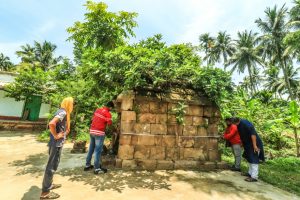INTACH Discovers An Ancient Temple near Pipili in Odisha
Bhubaneswar: A survey team of the Indian National Trust for Art & Cultural Heritage (INTACH) has stumbled upon the ruins of an ancient temple at Biropurusottampur in Pipili Tehsil which may date back to the 6-7th Century CE and is likely to be one of the earliest temples from the Post- Gupta era.
The four member’s team led by project coordinator Anil Dhir, research assistant Deepak Kumar Nayak, Subhashish Dash and Suman Swain documented the ancient site. INTACH is also conducting a detailed survey of the Ratnachira Valley and its monuments.
 Emphasising on the historical importance of the region, Deepak Nayak, a member of INTACH said, “The region was a part of the South Toshali area of the ancient Kalinga kingdom, mentioned in copper plate inscriptions of the post-Gupta period. The bronze plates of Sri Lokavigraha and Olasingh plates of Bhanuvardhana, issued in the 6-7th Century CE, throw light on worshiping Maninagesvar (Shiva) and Naga Cult of the South Toshali region. Considering the material and style of the temple, it could be 1300 to 1400 years old and possibly the oldest intact temple in the region.
Emphasising on the historical importance of the region, Deepak Nayak, a member of INTACH said, “The region was a part of the South Toshali area of the ancient Kalinga kingdom, mentioned in copper plate inscriptions of the post-Gupta period. The bronze plates of Sri Lokavigraha and Olasingh plates of Bhanuvardhana, issued in the 6-7th Century CE, throw light on worshiping Maninagesvar (Shiva) and Naga Cult of the South Toshali region. Considering the material and style of the temple, it could be 1300 to 1400 years old and possibly the oldest intact temple in the region.
Anil Dhir, who had earlier completed the detailed survey of the Prachi Valley and the Ancient Jagannath Sadak, said that similar temples were seen in the Mahendragiri hill ranges of Southern Odisha. “The square shaped Khandolite stone blocks have no binding or cementing, they are placed one over other in symmetry to constitute the temple wall and roof. No evidence of iron clamps has been seen. The neatly chiseled blocks denote an era when Kalingan traditional temple architectural style was in its infancy. The temple is devoid of any external embellishments on both the inner and outer walls; even the parsadevata niches are empty,” said Dhir.
Concerned about the conservation of the temple, he said, “The ancient monument is in a very precarious state and on the verge of collapse. Growth of thick vegetation on the top and the sides has caused severe damage. The thick roots have split the stone blocks and wide cracks have developed, the rear wall is dangerously leaning backwards. The Garbhagruha gets flooded because of the leaks on the roof. The entire temple may crumble down anytime if proper measures are not taken immediately.”
Experts believe that Ratnachira Valley could be a treasure house of many archaeological wonders. A detailed survey is being undertaken by the team and many temples have been recorded, some of them in total ruins.

Comments are closed.